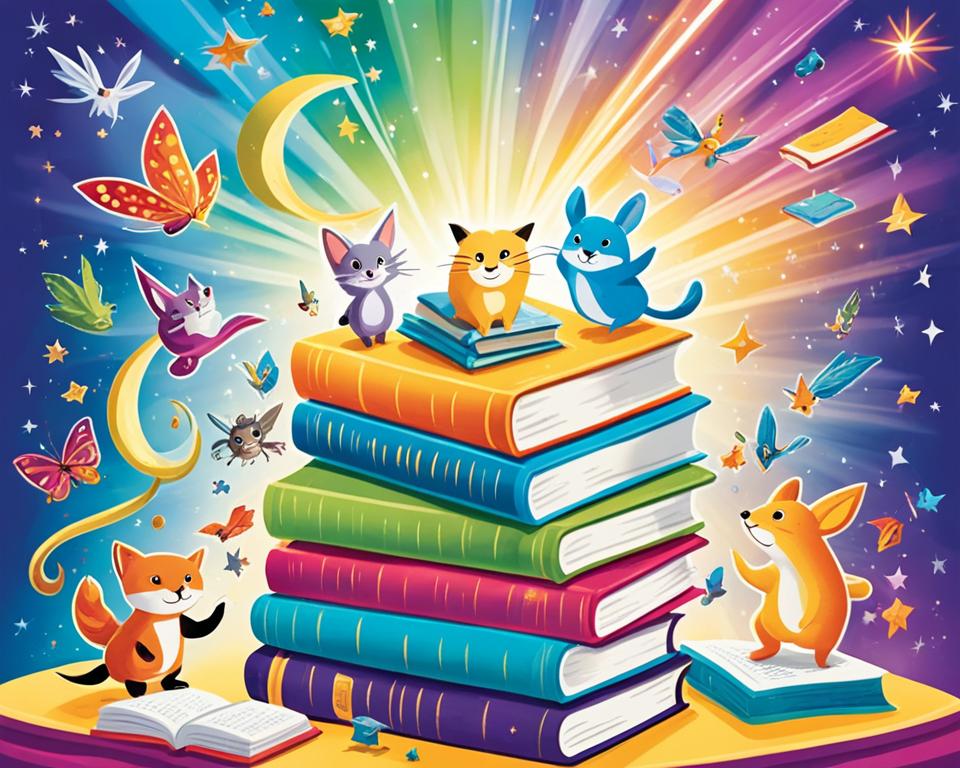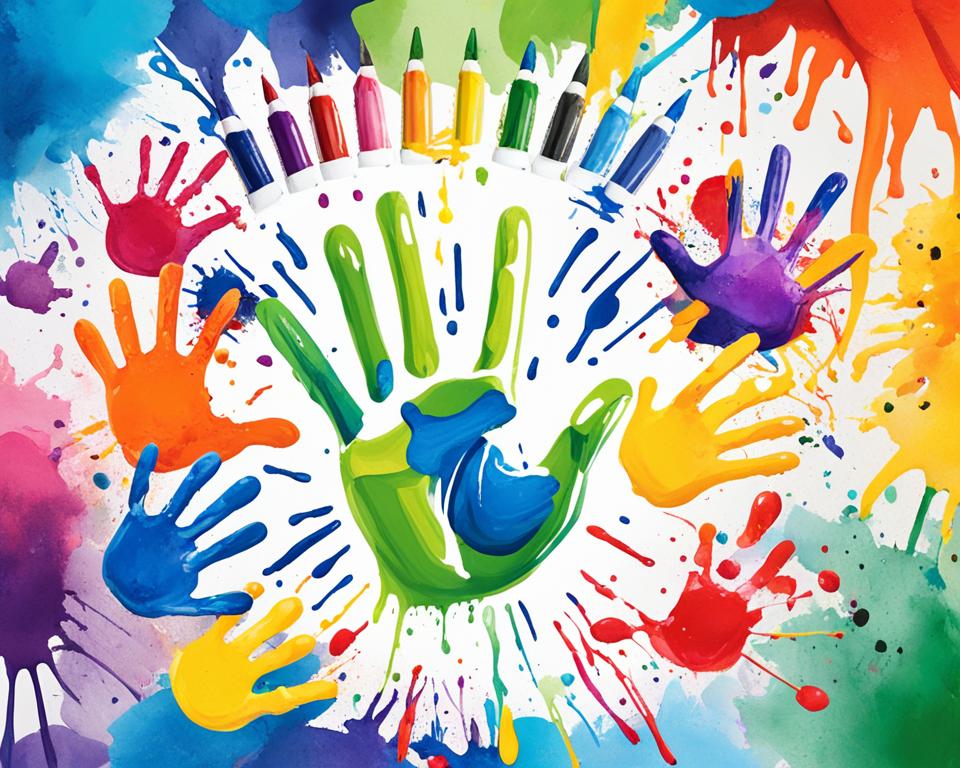Children possess a natural inclination towards creativity and imagination. As parents and educators, it is vital to provide them with avenues to explore and express their artistic talents. In this article, we will delve into the world of popular types of children’s art, unleashing the power of books, paintings, and pictures that capture young minds and ignite their creative spirits.
Exploring Popular Types of Children’s Art & Creativity
Check out art work to designed for children from these local St. Louis artists.
Children’s Art
Key Takeaways:
- Children’s art nurtures creativity, imagination, and self-expression.
- Books for children foster a love for storytelling and imagination.
- Paintings for kids enable visual creativity through vibrant colors and bold strokes.
- Pictures serve as a catalyst for children’s creativity, capturing moments and emotions.
- Exploring popular types of children’s art enriches their growth and appreciation for the arts.

Children’s Books: A Gateway to Imagination
Children’s books have always held a special place in the hearts of young ones, fostering a love for art, storytelling, and the wonders of imagination. Picture books, illustrated stories, and children’s literature create a magical realm that captivates young readers, ignites their creativity, and nurtures a lifelong love of books.
Whether it’s a tale of adventure, friendship, or a journey to far-off lands, storytelling for kids through beautifully crafted children’s books allows young minds to explore different worlds and characters. Through vivid imagery and captivating narratives, children’s literature opens the door to endless possibilities, encouraging young readers to dream big, think imaginatively, and expand their understanding of the world around them.
Picture books, with their stunning illustrations, bring stories to life and engage young readers visually. These beautifully crafted works of art not only spark curiosity and delight but also help develop important cognitive and emotional skills in children. The combination of captivating visuals and well-crafted texts in picture books creates an immersive reading experience that stimulates the imagination and fosters a love for reading.
Benefits of Children’s Books:
- Enhance language and literacy skills
- Spark imagination and creativity
- Promote empathy and understanding
- Encourage critical thinking and problem-solving
- Build a strong foundation for academic success
Reading children’s books is not just about storytelling; it is a gateway to unlocking a child’s intellectual, emotional, and social development.
In addition to the joy and wonder it brings, children’s literature plays a crucial role in shaping a child’s worldview and helping them develop essential life skills. As young readers immerse themselves in stories, they learn about different cultures, traditions, and experiences, fostering empathy, understanding, and acceptance of others.
The Power of Illustrated Books:
Illustrations in children’s books serve as visual cues that aid in comprehension, making the reading experience engaging and accessible for both younger and reluctant readers. Colorful and vibrant illustrations not only capture the attention of young readers but also enhance their understanding of the story, characters, and plot. Visual storytelling through illustrated books allows children to interpret and connect with the narrative in their unique way, fostering a lifelong love for art and creative expression.
Children’s literature is a treasure trove that nurtures young minds, stimulates imagination, and instills a passion for books. By immersing themselves in the enchanting world of children’s books, young readers embark on a journey of self-discovery, empathy, and wonder that will stay with them for a lifetime.
Paintings and Pictures: Colors Come to Life
The Power of Visual Creativity for Children
When it comes to children’s artwork, the possibilities are endless. From finger painting to watercolors, young artists can explore their creativity through vibrant colors and bold strokes. This form of creative expression allows children to express themselves and bring their imagination to life. Paintings for kids are not just a means of artistic exploration but also a way to develop fine motor skills, critical thinking, and emotional intelligence.
Colorful illustrations have a remarkable impact on a child’s visual perception. They engage children’s attention, stimulate their imagination, and encourage storytelling. A kid-friendly art style, filled with bright hues and whimsical characters, captivates young minds and invites them into a world of wonder.
“Mommy, look what I made!” exclaims Lily, holding up her latest masterpiece.
Children’s artwork isn’t just about the end result; it’s about the joy of the creative process. Exploring different painting techniques and experimenting with different tools and mediums allows children to discover their own artistic style. Whether it’s using brushes or sponges, exploring abstract shapes or creating detailed illustrations, each stroke on the canvas becomes a visual representation of a child’s unique perspective.
Pictures: Capturing Moments, Memories, and Emotions
Pictures hold an incredible power to narrate stories, evoke emotions, and preserve memories. For children, photographs or drawings can be a way to capture special moments, like a family vacation or a birthday celebration. Preserving these memories through visual images allows children to reflect on their experiences, express their feelings, and take pride in their own creations.
Moreover, pictures serve as a catalyst for children’s creativity. A single image can ignite a child’s imagination, sparking a story or inspiring a new artwork. Whether it’s a vivid landscape, an action-packed scene, or a close-up of nature’s intricate details, visuals have the ability to transport children to new worlds and unlock endless possibilities.
The Journey of Visual Creativity
Engaging in paintings and pictures nurtures a child’s visual creativity and allows them to develop important skills. It encourages observation, attention to detail, and emotional expression. Through artistic exploration, children learn to communicate, think critically, and problem-solve, all while having fun!
Next, we will explore the diverse world of sculptures and crafts, discovering how three-dimensional art forms enrich children’s creativity and tactile experiences.

Conclusion
In conclusion, the world of children’s art offers a plethora of avenues for young minds to explore their creativity, imagination, and self-expression. From the enchantment of children’s books to the vibrancy of paintings and pictures, each form of artistic expression plays a valuable role in shaping a child’s artistic development.
Embracing popular types of children’s art fosters a love for creativity, storytelling, and visual stimulation, ultimately enriching their growth and nurturing a lifelong appreciation for the arts. Children’s books serve as a gateway to imagination, transporting young readers to magical worlds and fostering a love for storytelling. Paintings and pictures, with their vibrant colors and captivating imagery, allow children to visually express themselves and create masterpieces that reflect their unique perspectives.
Whether through written words or visual strokes, children’s art empowers young minds to explore their creativity, develop their own artistic voice, and find joy in the act of creating. By embracing and encouraging their artistic pursuits, we provide a nurturing environment that not only enhances their artistic skills but also cultivates a sense of curiosity, self-expression, and emotional well-being. As children engage with different forms of art, they gain confidence, develop critical thinking skills, and learn to appreciate the beauty and diversity of the world around them.
FAQ
Are there any recommended books for children that can enhance their creativity?
Absolutely! There are numerous books that can stimulate children’s imagination and creativity. Some popular ones include “The Dot” by Peter H. Reynolds, “Ish” by Peter H. Reynolds, and “Not a Box” by Antoinette Portis.
How can children’s books contribute to the development of storytelling skills?
Children’s books provide a wonderful platform for nurturing storytelling skills. Through engaging narratives and vibrant illustrations, children are exposed to different story structures and characters. This exposure helps them develop their own storytelling abilities, imagination, and language skills.
What are some popular types of paintings for kids?
Paintings for kids come in various forms, from finger painting to watercolors. Some popular types include abstract art, nature scenes, and animal illustrations. These paintings allow children to explore their creativity, experiment with colors, and express their emotions.
How can pictures inspire creativity in children?
Pictures have a remarkable ability to spark children’s imagination and creativity. They serve as visual stimuli, encouraging children to create stories, imagine new worlds, and express their thoughts and emotions through art. Pictures provide inspiration and ignite a child’s visual creativity.